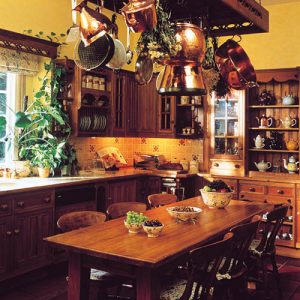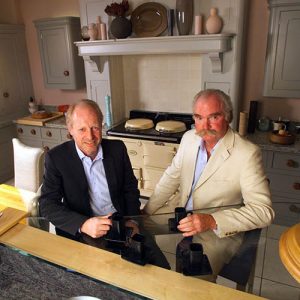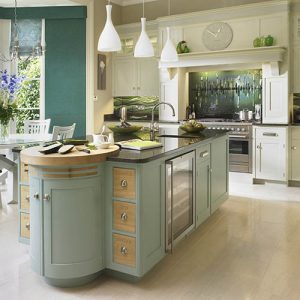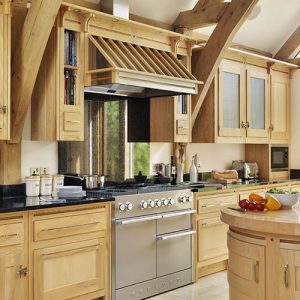Charlie Smallbone, founder of Smallbone of Devizes, looks back fondly on how he first met Mark Wilkinson, how they started working together and how he soon came to recognise him as an ‘incredible talent’
It was a sad moment when I received the call, on Wednesday morning [July 5]. Mark died peacefully in his sleep that morning, after what I know was a valiant fight. Though my contacts with Mark since 2009 are best described as sporadic, on each occasion I could feel the glint of his eyes on me, like a known humour shared between two old friends and associates – a subconscious bond.
Mark and I go back a long way. I first met him in 1975. I had just finished university and went one Saturday evening with Graham Clark to a destination in Villa Road, Brixton. When we arrived, I found out that this wasn’t just a house, but a whole street of interlinked knocked-through houses – a communal squat. Mark appeared, long hair, walrus moustache, dressed head to toe in white – really – what a striking sight.

Two years passed and Graham had joined me in a cottage just outside Devizes – we were now called Smallbone and Co. We were buying, renovating and then selling antique pine furniture. Mark had moved to Roadwater in north Somerset and dropped in overnight on his way through from an excursion to London. We had a wild evening and then next morning, while Graham and I were out stripping and polishing various items of furniture that we were readying for sale, Mark strode out in denim shorts and white clogs (a trademark look of his), and asked what he could do to assist.
That morning he made us a dovetail drawer from remnants of the cupboard under renovation, and other bits of scrappy timber we had lying around for renovation purposes. We were blown away – it was perfect, and it had taken him two hours at most. All the joints were cut by hand, using our rather inferior tools – and he’d sharpened my chisels too, so he could make the best job.
In short order, we suggested a new collaboration. Mark found a workshop just outside Roadwater. Graham and I alternated trips in a Luton Transit van every fortnight or so from Devizes to Somerset. On the out trip, we took a mix of salvage timber, and newly-stripped elements of largely decrepit antique pine furniture that Graham and I had painstakingly extracted from Ireland, haggling with gypsy travellers at Rathkeale, and bought.
We agreed what the pieces would become while with Mark in the workshop. There was no heating and it was frighteningly cold in winter. We would time the trips to ensure an overnight, and then return the following day with the gear, which Graham and I then finished and sold. This process formed our collective education, creative vision, in the understanding of furniture and how we might all make a living.
It was after about 10 months of doing this that I was talking to a lovely man we sold furniture to – David Crewe Read, owner of The Pinemine, nicknamed Screw. He had a client who actually wanted a whole kitchen. He asked if we could help and, if so, were we interested?
At the time, of course, we had no idea about what a fitted kitchen was. All we had ever built were one-off pieces of furniture that we pretty much made up as we went along. This new idea seemed exciting to me. I had found a client, and I knew that Graham had the chutzpah to convince them, and Mark… Well, Mark could actually make it happen. So I said yes to Screw and off we went to the races.
My work was already pretty much done, I’d found the client, and taken the idea to Graham and Mark. I just had to find the timber, get it stripped and down to Mark. Graham met the clients, who gave him a layout for their space – from a German kitchen company – for us to realise in our own form. Yes, even then this went on.

On looking at the layout, Mark immediately saw a huge problem. All the cabinets were 600mm wide. Our furniture to date had been dressers or similar, with doors normally around 400 to 450mm maximum width. As most of the timber I was buying was up to 120mm width, this was a serious problem. We had always assumed our design would incorporate our by then well-established T-bar door, but of course this would be impossible now. Very quickly this problem was solved. Mark came up with the idea to broaden the horizontal panel and then add an additional vertical panel, and lo we had a solution to the 600mm-wide door. This was just one of many similar problems that Mark personally overcame in getting this kitchen designed, built and then installed. Graham and I handled client contact and general labouring duties as required for Mark.
I knew from this whole experience that Mark really was an incredible talent.
At this time, he was courting Cynthia. Their relationship started right around the time we made the first kitchen. As ever with Mark, the courtship was to my
eyes exceptional – a certain old-school sensibility which, at the time, I could not quite fathom, as it seemed to me to sit at some distance from the Mark I was getting to know, who could only be described as larger than life.
Of course, now I see it better. This part of Mark’s character revealed a generosity of spirit for those he loved and called friends. But we could all see at that time that his emotions for Cynthia were at a different level, and he was very happy and completely open to all to share the strength of his emotions. This emotion was also transmuted into his work – the origination of the sensitivity of spirit that naturally went into his creative process.
In that autumn of 1978, Mark moved up to Devizes to be with Graham and myself to better develop what we had started. Every weekend without fail, he would depart back to Somerset with a new gift of totally unique woodwork that he had found some time in the week to build, with which to woo Cynthia.
By January, Cynthia was also in our house with Graham, my partner Sue, and myself.
At that time, Mark had a gold-coloured automatic Jag 2.8 – leather seats, walnut dashboard. He had an all-encompassing love of Ian Dury and the Blockheads, mustard – lashings of it with almost everything – and rollmop herrings, eaten most days for lunch in a unique and fascinating fashion – unwrapped to full length, the onions scraped off and dangled immediately above the moustache before devouring in one mouthful. These things, again, I now see in much better context.
He never mentioned his dyslexia – it was never relevant on one level, but of course was incredibly relevant on another. We never discussed this at the time – we had no reason to. I know I had a vague feeling of a connection between Mark’s supreme craft ability, and his totally unique, yet incredibly sensitive approach to his craft. His craft was art. He was less interested in actually selling things. He always had a total conviction in the value of what he did, and rightly so.
The Jag was much loved. On occasions, we would take it to Beckhampton for a pre-breakfast spin up the A361 – 120mph was the best achieved. On another occasion, we went to Streatley, where Graham and I had grown up, to fit a kitchen that Graham’s parents had commissioned from us. As we went down Streatley Hill – a very steep hill with a dangerous junction and traffic lights crossing a major road at the bottom. Mark turned to me, smiling, and said he had his foot full on the brakes and we were still gaining speed. I said this might be problematic because of the junction at the bottom. “No worries,” he said. “I’ll just put the gearbox into Park.” I was fully reassured. In fact, this course of action was not needed and we pulled up smoothly to the lights after a lot of vigorous foot pumping from Mark. This was just yet another example to me of his total practicality – a man to rely on, to put your faith in.
Mark and Cynthia duly married in summer of 1980. By this time, Smallbone was rocking – maybe too much so. We were busy. Mark was controlling a workshop with by now more than 40 to 50 employees. Graham and I were out designing and selling the kitchens to fuel the monster we were creating.
‘Graham and Mark came up with the idea of creating a hybrid product, by going to a melamine sheet kitchen producer and getting them to produce modular carcasses for us. The frame, which was key to our style of kitchen, had to be adapted to work within a carcass-based system. Mark did this. Thus was the ‘in-frame’ kitchen born. Mark Wilkinson design titan – I rest my case’
We had realised during the build and install of our initial project that, while our old timber gave our furniture a really unique feel, it was not ideal for the internal elements of the kitchen. Exactly who did what at that time is hard to recall. I believe it was Graham and Mark together, for instance, who came up with the idea of creating a hybrid product, by going to a melamine sheet kitchen producer and getting them to produce modular carcasses for us, into which we could then put modern kitchen accessories.
Graham found a company in Essex called New World Kitchens to do the carcasses for us. The frame, which was key to our style of kitchen and gave it the natural furniture-inspired feel, had to be adapted to work within a carcass-based system. It also needed to be attached to the carcass in a way that could create continuity. Mark did this.
He designed individual frames for each carcass and then came up with the idea of a cover strip to overlay the join between cabinets. He took a sized-up version of the astragal mould that we were using on bookcases that we were making at that time. He then came up with the idea of attaching the frames to the carcass.
Thus was the ‘in-frame’ kitchen born. Mark Wilkinson design titan – I rest my case.

One night right after Christmas in 1980, we were all at home. It was after dinner when we realised that the house was on fire. The house almost went up that night. It was a thatched cottage and would have done, if we had not put in 30 minutes of intense and immediate effort to stay the spread. The heat and the smoke were intense. Mark found the 50 pint drum of Wadworth 6X we had purchased the day before, managed to manhandle it into the fire zone, with some assistance, and then to cut it somehow. The heat and smoke were intense and I still remember us crawling into that room to try to slow the fire down. With the help of the fire brigade, we managed to save the house, but they were upset about the sacrifice of the 6X. We had all worked together – at that time, we worked together and played together.
With hindsight, it was apparent in our business that things were changing. In truth, we were selling at a faster rate than we could produce – especially given the originality and individually-crafted nature of our product. Mark confided in me one day that he really was not enjoying how his work life had become so uncreative. It was like all the bits he didn’t actually like doing were what he was being asked and expected to do each day. But he did them. His strength and force of character demanded competence from all around and under him. He was a force of nature. Mark and I shared our concerns and our relative uncertainties about how Smallbone was evolving.
In 1981, Mark and Cynthia found a small cottage just outside Bromham and moved there.
Mark left Smallbone in 1982. By then, we knew that his unique talents would no longer be accommodated within the ever stricter confines of how Smallbone was rapidly growing. Mark needed a vehicle in which he could fully express himself, and which was his and his alone.
This was Mark Wilkinson Furniture – originated by Mark and by Cynthia to showcase these unique talents. Alongside, and joined at the hip to the business, were the two amazing properties that that just kept growing and evolving adjacent to his workshops and showroom at Bromham over the next 20 years.

Mark was really a Renaissance man. His talents were rooted in his character and extended so far beyond his consummate cabinetmaking ability. He was an engineer and an artist – delighting in facets that challenged his intellect. He had an ability to think something, then to sketch it accurately freehand, then to express this either within himself, if he was building the item, or to others, so that they could realise such items. He was a truly creative persona – an original thinker.
Another side of Mark will be known to anyone who visited him and Cynthia at their home. The incredible fully working model of HMS Victory – accurate and executed by his own hand in painstaking miniature. Then there was the tree house in a field near their home. So many amazing items, all designed and constructed while he and Cynthia worked tirelessly to build MWF into the incredible business it has become.
Able to work simultaneously on different and varied fronts, Mark understood delegation and confided to me on occasion that his secret was to identify specific talents that he did not possess and deploy the people with these talents on his behalf.
In 2005, I contacted Cynthia and Mark, this time to see if they thought it a good idea that we might join forces again. MWF was by now a powerhouse of a business – one of the absolute major innovators and evolving forces that served to develop the kitchen industry to what it is today. Sales revenues were close to £20 million annually – all creative decisions originated by and controlled by Mark, with Cynthia’s deft and resolute touch absolutely central at the core, having guided and controlled the company growth in a totally organic way for close to 20 years.
But the real thing about MWF was that, despite its size, clients felt a personal connection – as if Mark would personally be arriving to design their new kitchen. This connection between company and client was a special bond that underlay the exceptional nature of what Mark and Cynthia built at MWF. Something, in reality, much easier to articulate than to actually achieve.
While building the business, Mark and Cynthia still found the time to bring up their two wonderful children, Gregory and Victoria. Mark also became very involved in dyslexia charity work, delighting in the way that he could, and indeed had, become this most fantastic role model.
The man was immense. I can now see the force of his character, replete with his wicked sense of mischief and humour, as the total creative package. He used to tell me he hated school. He would go out of his way to pull a daily ‘sickie’ by smoking five cigarettes simultaneously on the bus to school. When he got off, he would complain of feeling too sick to go in that day. He left school without any qualifications, except his major one – himself, his force of character and the belief in his own ability. Despite his loathing of school, he has worked tirelessly to educate all those around him – myself included: a beautiful conundrum, just like the man himself.